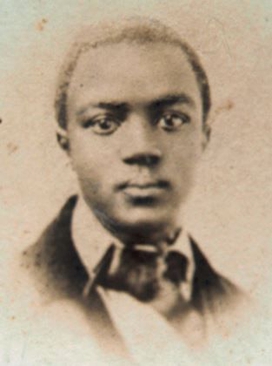Jesse Ewing Glasgow facts for kids
Quick facts for kids
Jesse Ewing Glasgow
|
|
|---|---|
 |
|
| Born |
Jesse Ewing Glasgow Jr.
c. 1837 |
| Died | 20 December 1860 (aged 22–23) Edinburgh, Scotland
|
| Known for | African-American transatlantic intellectual |
Jesse Ewing Glasgow Jr. (born around 1837 – died December 20, 1860) was a smart and influential African-American writer from Philadelphia. He studied at the University of Edinburgh in Scotland from 1858 to 1860. He wrote an important pamphlet about John Brown's raid on Harper's Ferry in 1859. This raid was an attempt to start a slave revolt in the United States.
Contents
About Jesse Glasgow's Life
Jesse Ewing Glasgow Jr. was born around 1837 in Philadelphia. He was born a free African American. His father, Jesse Glasgow, worked as a whitewasher, painting walls and buildings. His father was also an active member of the African American community in Philadelphia. He even signed a famous paper called "Men of Color, To Arms! Now or Never!" in 1863. This paper encouraged Black men to join the army during the American Civil War.
When he was 14, Jesse Glasgow Jr. started attending the Institute for Colored Youth (ICY). This school opened in 1837.
The Institute for Colored Youth
The Institute for Colored Youth was a highly respected school for Black students. It first started as a trade school, teaching skills for jobs. But it soon changed to teach a wide range of subjects, like a regular college. The school also hired Black teachers, which was very important at the time. Famous teachers like Professor Charles L. Reason and Robert Campbell taught there.
Jesse Glasgow was an excellent student at the Institute. He stood out even among other very smart students. One of his teachers, Frances Jackson-Coppin, told a story about him. The school principal invited a phrenologist to the school. A phrenologist was someone who claimed they could tell how smart people were by studying the shape of their head. This phrenologist believed that Black people were not as smart as white people.
But Jesse proved him wrong. His teacher said that when the phrenologist asked to see the best class, Jesse was there. He was a very dark-skinned boy. Jesse solved math problems on the board very quickly and easily, showing how smart he was.
In 1856, Jesse Glasgow became the first student to graduate from the Institute for Colored Youth. After that, he earned a spot at the University of Edinburgh in Scotland. Because he was known for being so smart, many people helped pay for his trip and his school fees. At Edinburgh, Jesse did very well in all his classes. He won several awards for his studies in Greek, English, and mathematics. He graduated in 1858.
His Impact in Scotland
Even though Jesse Glasgow was in Scotland, he stayed connected to the African American community in Philadelphia. He was involved with the Banneker Institute. This group was named after Benjamin Banneker, a famous African American mathematician. The Banneker Institute started in 1853. It was one of many groups in Philadelphia that helped Black people learn and debate ideas.
The Institute was created by and for Black Philadelphians. Its main goal was to help Black people educate themselves. They wanted to create a strong sense of unity among Black people. This would help them become informed leaders for African Americans. The Banneker Institute encouraged young people from the Institute for Colored Youth to join. Jesse's friends and fellow graduates, Jacob C. White Jr. and Octavius Catto, also became leaders in the group.
Jesse Glasgow's Death
On December 20, 1860, Jesse Glasgow died from tuberculosis. He was only 23 years old. He passed away in his home in Newington, Scotland, before finishing all his studies at Edinburgh.
Newspapers in Scotland and the Banneker Institute remembered his death. The Banneker Institute shared their sadness. But they also celebrated Jesse's amazing achievements in school. They wanted to show how smart people of African heritage could be. They also wanted to challenge the wrong idea of white supremacy, especially in schools and politics.
Reading Jesse Glasgow's work helped change how people saw African-descended people in the United States and Great Britain. His clear arguments against slavery reached many people across the Atlantic Ocean. This helped the cause of ending slavery. Jesse himself showed how successful a good education could be for young Black people. At a time when many people wrongly believed that African heritage meant being less smart, Jesse Glasgow proved them wrong. He gained international support for a big social and political movement.

